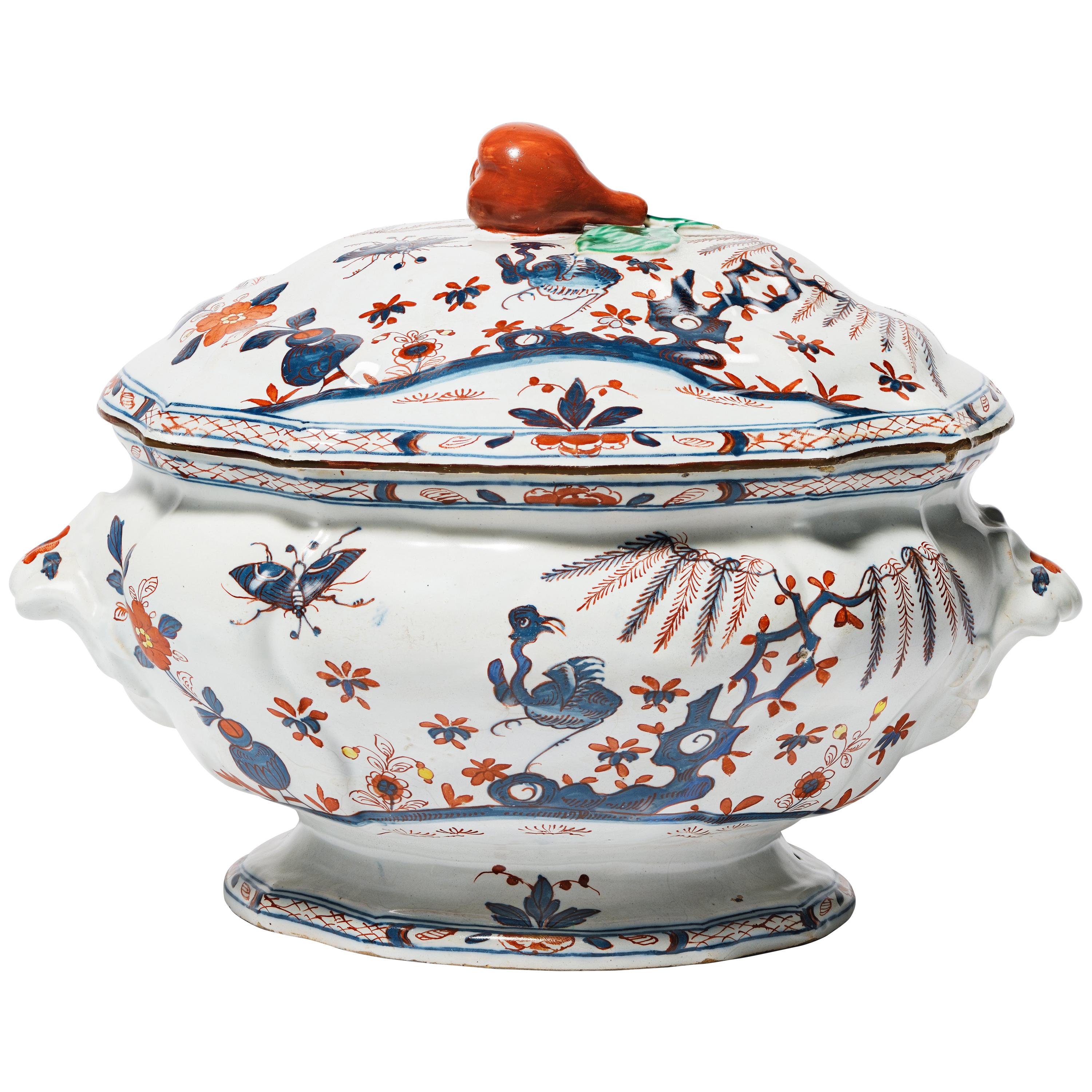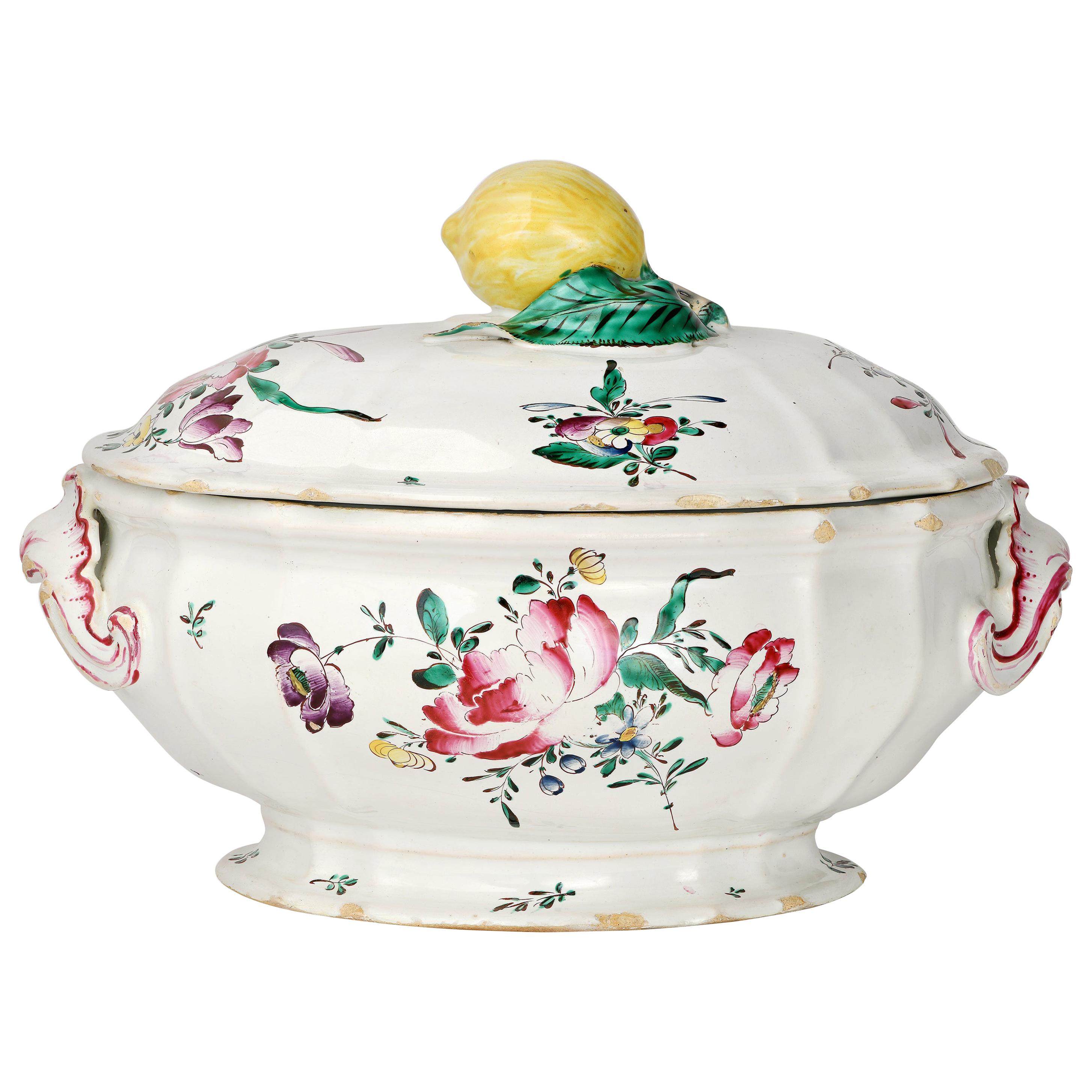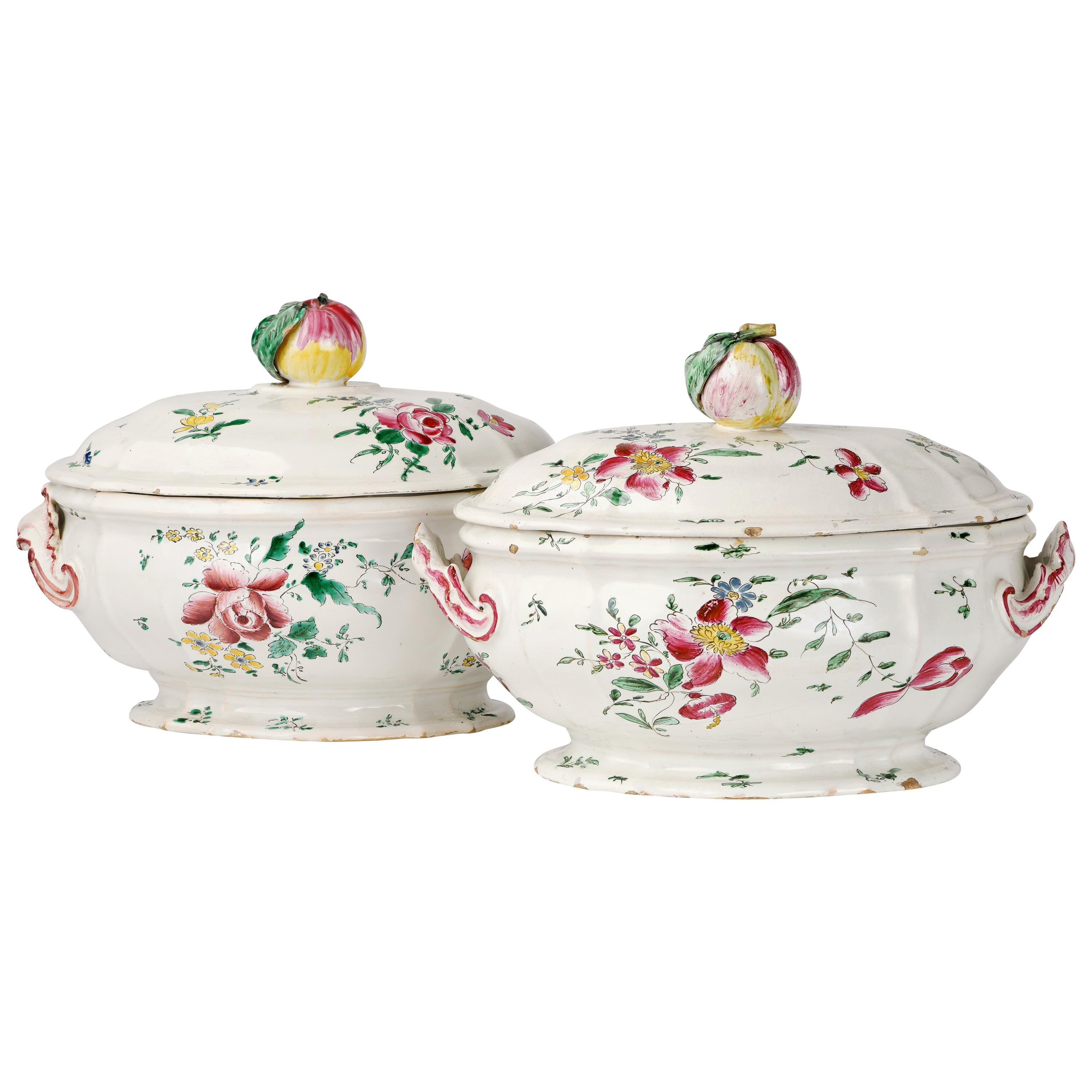Items Similar to Ancient Italian Maiolica Tureen, Rubati Manufacture, Milan, circa 1770-1780
Video Loading
Want more images or videos?
Request additional images or videos from the seller
1 of 20
Ancient Italian Maiolica Tureen, Rubati Manufacture, Milan, circa 1770-1780
About the Item
Maiolica tureen
Pasquale Rubati Manufacture
Milan, circa 1770 - 1780
Maiolica polychrome decorated “a piccolo fuoco” (third fire).
It measures 6.69 in x 11,02 x 8.26 (17 x 28 x 21 cm)
Weight: 2.356 lb (1.069 kg)
State of conservation: a fêlure affects part of the basin. Some chips on the handles and on the edge of the lid.
The maiolica and porcelain factories of the eighteenth century mainly belonged to great royal or noble families who made the manufacture of ceramic works a motif of prestige. In Milan instead, under Maria Theresa of Austria, we observe the opening of new factories which, by virtue of the privatization granted by the government, took a real business risk and gave rise to flourishing factories.
The oval-shaped tureen rests on a low, flared foot and features ribbed walls with applied handles, protruding in the shape of a volute; the rounded and ample lid, follows the shape of the body and ends with a small pear-shaped grip with a thin leaf in relief. A brushstroke of manganese appears inside the lid and under the base of the bowl: the traditional “chiodo” (“nail”) to indicate that the pieces that come out white from the high-fire must be taken to the "pittorìa" to be decorated over a third fire.
This shape belongs to both eighteenth-century Milanese manufactures (Clerici and Rubati) and several examples with different decorations are known: “al carabiniere” (R. Ausenda, Musei e Gallerie di Milano. Museo d’Arti Applicate. Le ceramiche. t. II, Milano 2000 pag. 289 n. 307) and “allo struzzo” (idem, p. 305 n. 309). The pictorial formula of the "Transburgo flower" decoration used here leads us to attribute it to the Pasquale Rubati manufacture.
The decoration, painted symmetrically on the body and lid, shows large polychrome flowers, roses or tulips, accompanied by small rural flowers. Semis of flowers and small leaves scattered on the remaining surface complete the ornamentation.
The aforementioned introduction in 1760 of the innovative “a piccolo fuoco” (third fire) processing, which, by expanding the ornamental repertoire with Saxon-inspired floral themes, could commercially compete with the German porcelains which had one of their most renowned offerings in the naturalistic Deutsche Blumen.
Pasquale Rubati was originally from Lodi where he had worked at the Rossetti factory and then moved, first to Turin and later to Milan where he is documented among the painters of the Clerici factory. Accused by Clerici of having stolen "the secrets of the colors" from the factory, in other words the recipes for third fire colors, Pasquale Rubati set up his own manufacture. He stands out both for his extraordinary talent as a painter and for the quality of the works and the finesse of the decorations which often successfully imitate porcelain.
Bibliography:
S. Levy, Maioliche settecentesche lombarde e venete, Milano 1962;
A. Novasconi - S. Ferrari - S. Corvi, La ceramica lodigiana, Lodi 1964, ad Indicem; Maioliche di Lodi, Milano e Pavia (catal.), Milano 1964;
O. Ferrari - G. Scavizzi, Maioliche italiane del Seicento e del Settecento, Milano 1965;
M. A. Zilocchi, in Settecento lombardo, Milano 1991, pp. 492-496;
R. Ausenda, Musei e Gallerie di Milano. Museo d’Arti Applicate. Le ceramiche. t. II, Milano 2000; p. 289 n. 307; p. 305 n. 309.
- Creator:Pasquale Rubati (Manufacturer)
- Dimensions:Height: 6.7 in (17 cm)Width: 11.03 in (28 cm)Depth: 8.27 in (21 cm)
- Style:Rococo (Of the Period)
- Materials and Techniques:Maiolica,Glazed
- Place of Origin:
- Period:1770-1779
- Date of Manufacture:circa 1770-1780
- Condition:Minor losses. A fêlure affects part of the basin. Some chips on the handles and on the edge of the lid.
- Seller Location:Milano, IT
- Reference Number:1stDibs: LU4352233010082
About the Seller
4.3
Vetted Seller
These experienced sellers undergo a comprehensive evaluation by our team of in-house experts.
Established in 1860
1stDibs seller since 2018
19 sales on 1stDibs
Typical response time: 4 hours
Associations
International Confederation of Art and Antique Dealers' Associations
- ShippingRetrieving quote...Ships From: Milano, Italy
- Return PolicyA return for this item may be initiated within 14 days of delivery.
More From This SellerView All
- Ancient Maiolica Cup, Rubati Manufacture, Milan, Circa 1770 - 1780By Pasquale RubatiLocated in Milano, ITSick cup Pasquale Rubati Manufacture Milan, Circa 1770 - 1780 Maiolica decorated in polychrome “a piccolo fuoco” (third fire) It measures: h 2.36 x 7.4 x 7.87 (h 6 x 19 x 20 cm) ...Category
Antique 1770s Italian Rococo Ceramics
MaterialsMaiolica
- Ancient Italian Maiolica Tureen Milano, 1770 circaBy Pasquale Rubati, Felice ClericiLocated in Milano, ITMaiolica tureen “allo struzzo” (ostrich decoration) Milan, Felice Clerici or Pasquale Rubati factory, circa 1750-1780 Measures: 9.25 in x 12.79 in x 10.23 in (cm 23.5 x cm 32.5 x cm 26) lb 4.78 (kg 2.17) State of conservation, a felûre consolidated inside with slight edge chipping restored. In Milan in the 18th century two Majolica warehouses were opened, the first, by Felice Clerici, in 1745, the second in 1756 by Pasquale Rubati. Traditionally this type of decoration has been attributed to the Pasquale Rubati factory. In reality the motif “allo struzzo”, one of the clearest examples of how the taste for chinoiserie met with considerable success during the 18th century, had been produced, in specimens of greater or lesser quality, by both Milanese manufactories. This Maiolica tureen has a swollen and ribbed oval bowl, rests on an extroflexed foot and shows stirrup handles. The tri-color ornament, in the typical tones of Japanese "Imari" decorations, shows an idealized oriental landscape that develops around a perforated rock and has a willow tree with long lance-shaped leaves framing the long-legged bird figure. The ornamentation is enhanced by decorative elements such as butterflies, small florets and a vase with a thin flowery stem. The lid is ribbed with a pear-shaped knob on top. The decoration was called in the Milanese manufactories "allo struzzo" (ostrich decoration) and this refers to the oriental figure Xian He or the crane, symbol of longevity, here losing its symbolic value. It is hypothesized that among some 16th century engravings...Category
Antique 1770s Italian Chinoiserie Ceramics
MaterialsMaiolica
- Italian Maiolica Ancient Tureen, Lodi, 1770-1780By Antonio FerrettiLocated in Milano, ITMaiolica tureen Antonio Ferretti Manufacture Lodi, circa 1770-1780 Maiolica polychrome decorated “a piccolo fuoco” (third fire). It measures 9.05 x 12.59 x 9.05 in (23 x 32 x 23 cm) ...Category
Antique 1770s Italian Rococo Ceramics
MaterialsMaiolica
- Ancient Maiolica Plates Pasquale Rubati, Milan Circa 1770-1780By Pasquale RubatiLocated in Milano, ITFive oval maiolica dishes with pierced edge Manufacture of Pasquale Rubati Milan, 1770-1780 Three small oval dishes 10.23 in x 7.67 in (26 cm x 19.5 cm) Two large oval dishes 10.82 in x 8.85 in (27.5 x 22.5 cm) lb 3.5 (kg 1.8) State of conservation: intact The five dishes of different sizes have an oval shape, a mixtilinear edge and a molded polylobed shape with a surface enriched with a relief weave motif extending to the brim and forming a perforated basket...Category
Antique 1770s Italian Rococo Ceramics
MaterialsMaiolica
- Pair of Italian Maiolica Tureens, Ferretti Manufacture, Lodi Circa 1770 - 1780By Antonio FerrettiLocated in Milano, ITPair of maiolica tureens Antonio Ferretti Manufacture Lodi, circa 1770-1780 Maiolica polychrome decorated “a piccolo fuoco” (third fire). a – 8.66 x 11.02 x 7.48 in (22 x 28 x 19...Category
Antique 1770s Italian Rococo Ceramics
MaterialsMaiolica
- Antique Italian Maiolica Coolers Pasquale Rubati Manufacture Milan, 1770 CircaBy Pasquale RubatiLocated in Milano, ITAssortment of bottle and glass coolers in Maiolica. Pasquale Rubati manufacture Milan, circa 1770 Maiolica polychrome decorated “a piccolo fuoco” (third fire) a - Bottle cooler 5.91 in x 5.91 in diameter (15 x 15 cm ) Weight: 1.86 lb (845 g) b - Bottle cooler 6.89 x 7.87 in diameter (17,5 x 20 cm) Weight: 2.09 lb (948 g) c - Pair of glass-cooler vases 3.94 x 3.94 in diameter (10 x 10 cm) Weight: 1.43 lb (650 g) Good state of conservation: a - some chipping from use on the edge; a - two fêlures covered on the edge; c - one has deep chippings on the edge and the other a subtle fêlure. Two Majolica factories were active in Milan in the 18th century. The first, starting from 1745, was owned by Felice Clerici; the other one by Pasquale Rubati from 1756. Rubati was in competition with Felice, whose worker he had been prior to opening his own workshop. On his death in 1796, the business was continued for a few more years by his son Carlo. Recent studies have recognized Pasquale Rubati's contribution as the creator of "Strasbourg-style" decorations with their particularly joyful depictions. This style had previously been attributed to the Lodi manufacturers. These works here, however, are a clear example of this production. The Majolica containers have different sizes, a cylindrical shape and rest on a low foot ring. The two largest are completed by handles in the shape of a zoomorphic mask with wide open jaws, while the smaller ones have handles applied with an anthropomorphic mask. All the works are characterized by elegant floral decoration. The two twin glass coolers show bunches of flowers centered around a main corolla, a rose or a peony paired...Category
Antique 1770s Italian Rococo Ceramics
MaterialsMaiolica
You May Also Like
- Majolica Goose Tureen, circa 1950Located in Austin, TXBrown Majolica goose tureen signed on underside Caugant, circa 1950.Category
Vintage 1950s French Country Soup Tureens
MaterialsCeramic
- Majolica Bison Tureen Caugant, circa 1950By Michel CaugantLocated in Austin, TXMajolica bison tureen signed Michel Caugant, circa 1950.Category
Vintage 1950s French Rustic Ceramics
MaterialsCeramic
- French Majolica Rabbit Tureen circa 1940By Michel CaugantLocated in Austin, TXFrench Majolica rabbit tureen, circa 1940 signed "Caugant.".Category
Vintage 1940s French Country Soup Tureens
MaterialsCeramic
- Majolica Doe Tureen Caugant, circa 1950By Michel CaugantLocated in Austin, TXRare Majolica doe tureen signed Caugant, circa 1950.Category
Vintage 1950s French Country Soup Tureens
MaterialsCeramic
- Vintage Italian Ceramic Swan Soup TureenLocated in Pearland, TXA lovely Italian ceramic swan floral soup tureen. Maker's mark on reverse. This gorgeous tureen is in the form of a graceful swan with beautiful h...Category
Mid-20th Century Italian Soup Tureens
MaterialsCeramic
- French Green Majolica Tureen with Grapes, circa 1890Located in Austin, TX19th Century green Majolica tureen with grapes. East of France. Measures: height / 6.5 diameter / 6" by 5"Category
Antique 1890s French Rustic Soup Tureens
MaterialsCeramic, Faience, Majolica





